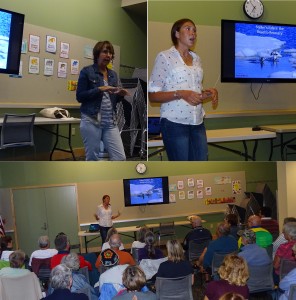Steller’s Eider researcher in Alaska, Tasha Di Marzio, gave a presentation to ABC on September 21, 2015, that was riveting! Many of us have heard of Tasha over the years of birding with Shelley Parker, Tasha’s mom, but the reality was even greater than the parental bragging rights! Tasha is a first class researcher, bold adventurer, arctic explorer, fabulous photographer, and great at doing presentations!
Tasha has chosen the eider that is the most difficult to study, but because of that needs study the most. These birds are down to 200 pairs in Alaska in 3 areas, one of which has almost been abandoned. Tasha’s work has mainly been in the Yukon delta, which she knows intimately from the mud up, spending months at a time “trapped” there with just a couple of others, studying these birds as well as the other wildlife of the area. Not a glamorous profession!
The study she is currently working on involves releasing captive-bred birds back to the delta in 2016, something her team has been agonizing over for several years as they have worked through the amazingly difficult project of how to raise these birds in captivity, figuring out which birds are attracted to which birds, how to make the eggs hatch in an incubator as successfully as in a parent’s nest (much harder than you would think!), and where to raise them (salinity turns out to be the limiting factor, a fact known only for the last 2 years and not published yet), and control of predators, especially Arctic Foxes.
Part of the reason the Yukon delta was chosen was cooperation with native tribes, something apparently not possible on the North Slope, and also not possible with Russia at the moment, where there are more Steller’s Eiders. The birds nest where the females say to nest, and the males always agree, but since they’re only monogamous for a season, those same males may go to Russia the next year. This is determined early in the year when hormones start to build on the wintering grounds and matches are made. When it’s time to go nest, they migrate northwards, some turning left to Russia and a much smaller group turning right to Alaska.
The reasons for an 80% decline in Steller’s eiders are not completely clear. Spectacled Eiders are also down about 80%, but the main reason is well known for them — lead shot, which is being dealt with, and there is much hope for them. Salinity in the nesting areas has gone way up, and that is thought to be one factor. But these studies are important to help pin down other causes as well as increase the numbers.
It was a privilege to have a peek into the life of this researcher, and we hope to see Tasha again in the future when she’s down here visiting family.
Click on photo below to enlarge. Kay Pullen introduces Tasha, then Tasha gets into her subject.


Tasha’s response and a link to a great video:
Thank you for all of your great feedback on my eider talk last Monday night.
What a fantastic group of people to present to!
Its very nice to get to share my passion with like minded people.
I know my talk went a little long but I had a final video that I wanted to share with the group, it is about 8.5 min long. I have attached the link so you all can view it if you’d like.
https://www.youtube.com/watch?v=4yyMEoqG0jA
Cornell made the video about the “one of my favorite spots in the world” the Yukon Delta National Wildlife Refuge.
It features a biologist Brian that I have a pleasure of working with each summer. After watching it you may start to understand why this area is so special to me.
Thanks again for inviting me to present and best of luck on your future birding adventures.
If your ever in Alaska feel free to look me up and we’ll go birding or come me at visit the Alaska Sealife Center.
http://www.alaskasealife.org/
Everyone in attendance is in Tasha’s debt for a wonderful presentation and for a career dedicated to helping save this endangered species. Keep her in your thoughts and prayers, and let’s hope that Steller’s eiders make a recovery with the help of Tasha and her team. Many thanks. Ed